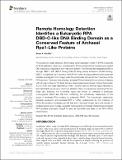Files in this item
Remote homology detection identifies a eukaryotic RPA DBD-C-like DNA binding domain as a conserved feature of archaeal Rpa1-like proteins
Item metadata
| dc.contributor.author | MacNeill, Stuart | |
| dc.date.accessioned | 2021-07-21T11:30:02Z | |
| dc.date.available | 2021-07-21T11:30:02Z | |
| dc.date.issued | 2021-07-20 | |
| dc.identifier | 274764701 | |
| dc.identifier | e907e57c-332f-4436-bf78-b79db778d417 | |
| dc.identifier | 85111906933 | |
| dc.identifier | 000878825000001 | |
| dc.identifier.citation | MacNeill , S 2021 , ' Remote homology detection identifies a eukaryotic RPA DBD-C-like DNA binding domain as a conserved feature of archaeal Rpa1-like proteins ' , Frontiers in Molecular Biosciences , vol. 8 , 675229 . https://doi.org/10.3389/fmolb.2021.675229 | en |
| dc.identifier.issn | 2296-889X | |
| dc.identifier.other | ORCID: /0000-0002-0555-0007/work/97473145 | |
| dc.identifier.uri | https://hdl.handle.net/10023/23612 | |
| dc.description | Funding: Open Access publication fees were provided by the University of St Andrews. | en |
| dc.description.abstract | The eukaryotic single-stranded DNA binding factor replication protein A (RPA) is essential for DNA replication, repair and recombination. RPA is a heterotrimer containing six related OB folds and a winged helix-turn-helix (wH) domain. The OB folds are designated DBD-A through DBD-F, with DBD-A through DBD-D being directly involved in ssDNA binding. DBD-C is located at the C-terminus of the RPA1 protein and has a distinctive structure that includes an integral C4 zinc finger, while the wH domain is found at the C-terminus of the RPA2 protein. Previously characterised archaeal RPA proteins fall into a number of classes with varying numbers of OB folds, but one widespread class includes proteins that contain a C4 or C3H zinc finger followed by a 100-120 amino acid C-terminal region reported to lack detectable sequence or structural similarity. Here, the sequences spanning this zinc finger and including the C-terminal region are shown to comprise a previously unrecognised DBD-C-like OB fold, confirming the evolutionary relatedness of this group of archaeal RPA proteins to eukaryotic RPA1. The evolutionary relationship between eukaryotic and archaeal RPA is further underscored by the presence of RPA2-like proteins comprising an OB fold and C-terminal winged helix (wH) domain in multiple species and crucially, suggests that several biochemically characterised archaeal RPA proteins previously thought to exist as monomers are likely to be RPA1-RPA2 heterodimers. | |
| dc.format.extent | 8 | |
| dc.format.extent | 2944736 | |
| dc.language.iso | eng | |
| dc.relation.ispartof | Frontiers in Molecular Biosciences | en |
| dc.subject | RPA | en |
| dc.subject | OB fold | en |
| dc.subject | Winged helix domain | en |
| dc.subject | Archaea | en |
| dc.subject | ssDNA | en |
| dc.subject | DNA repair | en |
| dc.subject | DNA replication | en |
| dc.subject | QH426 Genetics | en |
| dc.subject | 3rd-DAS | en |
| dc.subject | MCC | en |
| dc.subject.lcc | QH426 | en |
| dc.title | Remote homology detection identifies a eukaryotic RPA DBD-C-like DNA binding domain as a conserved feature of archaeal Rpa1-like proteins | en |
| dc.type | Journal article | en |
| dc.contributor.institution | University of St Andrews. Biomedical Sciences Research Complex | en |
| dc.contributor.institution | University of St Andrews. School of Biology | en |
| dc.identifier.doi | 10.3389/fmolb.2021.675229 | |
| dc.description.status | Peer reviewed | en |
This item appears in the following Collection(s)
Items in the St Andrews Research Repository are protected by copyright, with all rights reserved, unless otherwise indicated.

